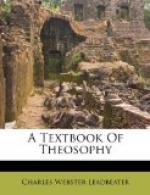An interesting branch of the subject is the study of the various shapes and colours taken by thought-forms of different kinds. The colours indicate the nature of the thought, and are in agreement with those which we have already described as existing in the bodies. The shapes are of infinite variety, but are often in some way typical of the kind of thought which they express.
Every thought of definite character, such as a thought of affection or hatred, of devotion or suspicion, of anger or fear, of pride or jealousy, not only creates a form but also radiates an undulation. The fact that, each one of these thoughts is expressed by a certain colour indicates that the thought expresses itself as an oscillation of the matter of a certain part of the mental body. This rate of oscillation communicates itself to the surrounding mental matter precisely in the same way as the vibration of a bell communicates itself to the surrounding air.
This radiation travels out in all directions, and whenever it impinges upon another mental body in a passive or receptive condition it communicates to it something of its own vibration. This does not convey a definite complete idea, as does the thought-form, but it tends to produce a thought of the same character as itself. For example, if the thought be devotional its undulations will excite devotion, but the object of the worship may be different in the case of each person upon whose mental body they impinge. The thought-form, on the other hand, can reach only one person, but will convey to that person (if receptive) not only a general devotional feeling, but also a precise image of the Being for whom the adoration was originally felt.
Any person who habitually thinks pure, good and strong thoughts is utilizing for that purpose the higher part of his mental body—a part which is not used at all by the ordinary man, and is entirely undeveloped in him. Such an one is therefore a power for good in the world, and is being of great use to all those of his neighbours who are capable of any sort of response. For the vibration which he sends out tends to arouse a new and higher part of their mental bodies, and consequently to open before them altogether new fields of thought.
It may not be exactly the same thought as that sent out, but it is of the same nature. The undulations generated by a man thinking of Theosophy do not necessarily communicate Theosophical ideas to all those around him; but they do awaken in them more liberal and higher thought than that to which they have before been accustomed. On the other hand, the thought-forms generated under such circumstances, though more limited in their action than the radiation, are also more precise; they can affect only those who are to some extent open to them, but to them they will convey definite Theosophical ideas.




